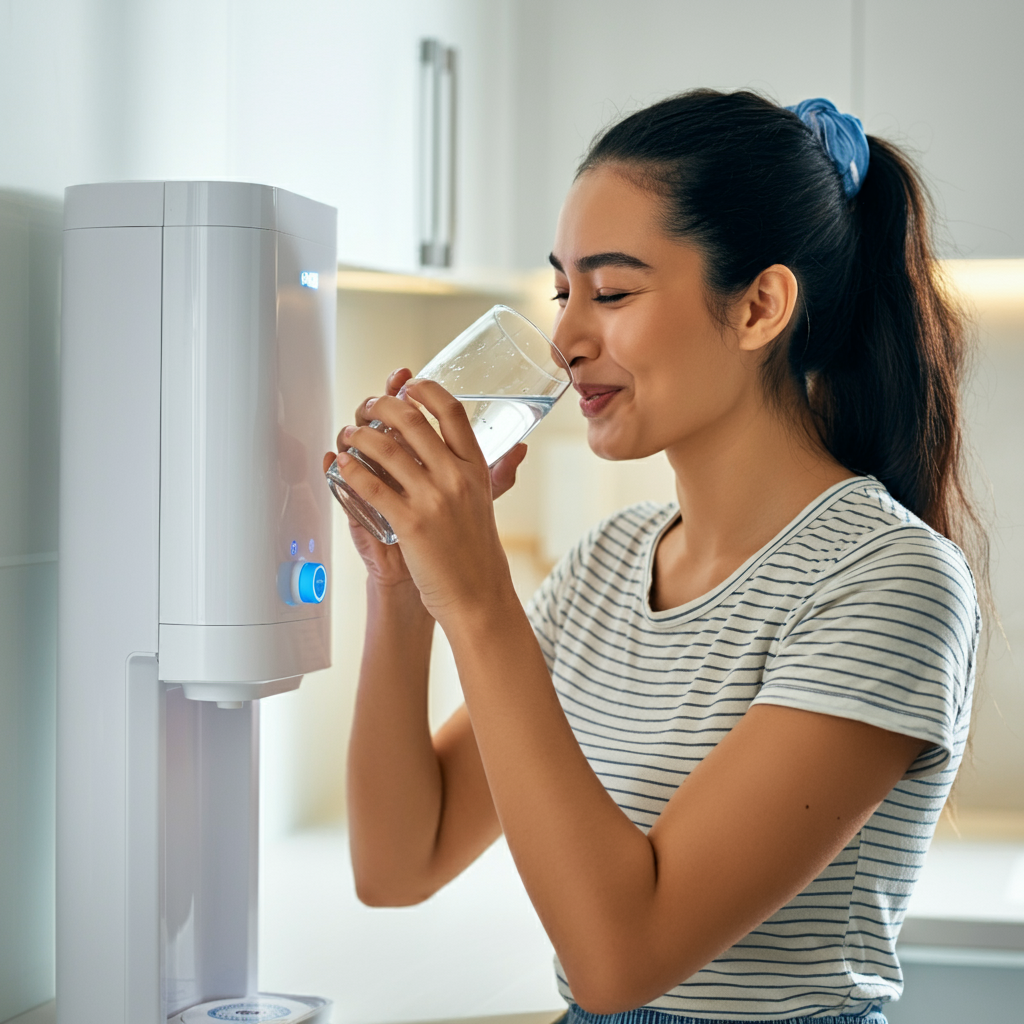Reverse osmosis (RO) systems primarily come in three main types: under-sink systems, whole-house systems, and commercial/industrial systems. Each type caters to different needs and applications, from providing clean drinking water at a single faucet to purifying water for an entire building or industrial process. At SoftPro Water Systems, we understand the importance of clean, high-quality water in your home. While we specialize in water softening solutions, we recognize that RO systems play a crucial role in removing a wider range of contaminants that water softeners alone cannot address. This article will explore the various types of RO systems available, helping you understand their differences, applications, and benefits.
Understanding Reverse Osmosis
Before we delve into the different types of RO systems, let's first establish a foundational understanding of reverse osmosis. Reverse osmosis is a water purification process that uses a partially permeable membrane to remove ions, unwanted molecules, and larger particles from drinking water. This process is pressure driven, forcing water through the membrane while leaving contaminants behind.
To better visualize this, imagine a fine mesh screen that allows water molecules to pass through but blocks larger contaminants. In reverse osmosis, the semi-permeable membrane acts as this screen, effectively separating impurities from the water. This process is vital for removing contaminants that may not be addressed by traditional filtration methods, such as dissolved salts, heavy metals, and pesticides.
The Water Quality Association (WQA) is a not-for-profit international trade association representing the residential, commercial, and industrial water treatment industry. The WQA plays a crucial role in promoting safe water quality through education, research, and advocacy. Their efforts help establish standards and certifications for water treatment products, including reverse osmosis systems, ensuring that consumers have access to safe and effective solutions.
Types of Reverse Osmosis Systems
Now, let's explore the three primary types of RO systems in detail:
Under-Sink RO Systems
Under-sink RO systems are compact units installed beneath a sink, typically in the kitchen. These systems are designed to provide a dedicated source of purified drinking water at a single faucet. They are popular among homeowners who want clean, great-tasting water for drinking and cooking without the need for a whole-house solution.
Under-sink RO systems are relatively easy to install and maintain, making them a convenient option for many households. They typically consist of a series of filters, including a sediment pre-filter, a carbon pre-filter, the RO membrane, and a post-filter. These filters work together to remove a wide range of contaminants, including sediment, chlorine, heavy metals, and dissolved solids.
APEC Water Systems and iSpring are two leading manufacturers of high-quality under-sink RO systems. These companies offer a variety of models with different features, capacities, and filtration stages to meet various needs and budgets. For instance, APEC Water Systems offers a 5-stage RO system that boasts a high daily output and efficient contaminant removal, while iSpring provides a compact 4-stage system ideal for smaller households.
Whole-House RO Systems
Whole-house RO systems, as the name suggests, are designed to filter all the water entering a home. These systems are installed on the main water line, providing purified water to every faucet, shower, and appliance in the house. This offers the advantage of having clean, filtered water for all purposes, not just drinking and cooking.
Whole-house RO systems are particularly beneficial in areas with hard water or high levels of total dissolved solids (TDS). By removing these minerals and contaminants, these systems can protect plumbing, appliances, and fixtures from scale buildup and damage. This can lead to increased lifespan for appliances like water heaters and washing machines, and reduced maintenance costs.
However, whole-house RO systems typically have a higher upfront cost and may require more maintenance than under-sink systems. They also tend to produce more wastewater, which is an important consideration for those who are environmentally conscious. To address this, manufacturers like Home Master have developed high-efficiency whole-house RO systems that minimize water waste through innovative technologies.
Commercial and Industrial RO Systems
Commercial and industrial RO systems are larger-scale units designed to meet the high-demand water purification needs of businesses and industries. These systems are used in various settings, including restaurants, hospitals, manufacturing plants, and even for desalination processes.
Commercial RO systems in restaurants, for example, ensure the production of crystal-clear ice and improve the taste of beverages and food. In hospitals, these systems provide purified water for medical equipment and patient care, maintaining a sterile environment. Industrial applications often require specialized RO systems designed to handle specific contaminants or high volumes of water.
Pentair is a leading provider of commercial and industrial RO systems, offering a wide range of solutions for various industries. Their expertise extends to designing customized systems tailored to specific water treatment needs, such as removing heavy metals from industrial wastewater or producing ultrapure water for pharmaceutical manufacturing.

Key Components of an RO System
While RO systems vary in size and application, they share several key components that contribute to their effectiveness:
RO Membranes
The RO membrane is the heart of any reverse osmosis system. It is a thin film with microscopic pores that allow water molecules to pass through while blocking larger contaminants. The effectiveness of an RO system largely depends on the quality and performance of its membrane.
Two common types of RO membranes are thin-film composite (TFC) and cellulose triacetate (CTA). TFC membranes are generally more efficient at removing contaminants and have a longer lifespan, while CTA membranes are more chlorine-tolerant. Membrane choice depends on specific water quality and application.
NSF International, a global public health organization, plays a vital role in certifying RO membranes and other water treatment components. NSF/ANSI Standard 58 establishes minimum requirements for the materials, design, and performance of RO systems, ensuring that they meet safety and quality standards.
Pre-filters and Post-filters
Pre-filters and post-filters work along with the RO membrane to enhance the overall performance and longevity of the system. Pre-filters are installed before the membrane to remove larger particles and sediment that could clog or damage the membrane. Common types of pre-filters include sediment filters and carbon filters.
Post-filters are installed after the membrane to further refine the water and improve its taste and odor. They can remove any residual contaminants or unpleasant tastes that may have passed through the membrane.
Storage Tanks and Pumps
Since RO systems purify water gradually, most systems include a storage tank to ensure a readily available supply of filtered water. These tanks can vary in size depending on the system's capacity and the household's water usage. Atmospheric tanks store water at atmospheric pressure, while pressurized tanks maintain a higher pressure for increased flow rate.
In some cases, booster pumps may be used to increase water pressure, which can improve the efficiency and output of the RO system. This is particularly useful in areas with low water pressure or for systems with high water demand.
Choosing the Right RO System
Selecting the appropriate RO system for your specific needs involves considering several factors:
- Water Quality: Have your water tested to identify specific contaminants and determine the level of filtration required.
- Daily Water Usage: Estimate your daily water consumption to choose a system with adequate capacity.
- Budget: RO systems range in price depending on their type, features, and capacity.
Professional installation and maintenance are also crucial for the optimal performance and longevity of your RO system. A qualified technician can properly install the system, ensuring correct connections and functionality. Regular maintenance, including filter changes and membrane replacement, is essential to maintain water quality and prevent system issues.
For expert advice on water treatment solutions, including water softeners and reverse osmosis systems, visit www.softprowatersystems.com.
Benefits of Reverse Osmosis
Reverse osmosis offers numerous benefits that contribute to improved water quality and overall well-being:
- Improved Water Quality and Taste: RO systems effectively remove contaminants that can affect the taste, odor, and appearance of water, resulting in cleaner, clearer, and better-tasting water.
- Removal of Harmful Contaminants: RO is highly effective in removing a wide range of harmful contaminants, including heavy metals like lead and arsenic, pesticides, bacteria, and viruses. This is particularly important for protecting the health of those with compromised immune systems or sensitivities to certain contaminants.
- Health Benefits: Drinking purified water can contribute to various health benefits, including improved hydration, reduced risk of exposure to harmful contaminants, and better overall health.
- Environmental Benefits: By providing a reliable source of clean drinking water at home, RO systems can reduce reliance on bottled water, minimizing plastic waste and environmental impact.
According to the Environmental Working Group (EWG), tap water can contain a variety of contaminants, including disinfection byproducts, pesticides, and heavy metals. A study published in the journal "Water Research" found that reverse osmosis was effective in removing over 90% of these contaminants, significantly improving water quality.
Reverse Osmosis vs. Other Filtration Methods
While reverse osmosis is a highly effective water filtration method, other technologies are also available, each with its advantages and disadvantages:
- Activated Carbon Filters: These filters use activated carbon to adsorb contaminants, primarily chlorine and improve taste and odor. They are less effective at removing dissolved solids and other contaminants compared to RO.
- UV Purification: This method uses ultraviolet light to kill bacteria and viruses but does not remove sediment, chemicals, or dissolved solids.
- Water Softeners: These systems, like the ones we offer at SoftPro Water Systems, are designed to remove calcium and magnesium ions that cause hard water. They do not address other contaminants typically removed by RO.
The best filtration method depends on your specific water quality concerns and desired outcome. For comprehensive contaminant removal and purified drinking water, reverse osmosis is often the most effective solution.

Maintenance and Troubleshooting
Proper maintenance is essential to ensure the long-term performance and efficiency of your RO system. This includes:
- Regular Filter Changes: Replace pre-filters and post-filters according to the manufacturer's recommendations, typically every 6-12 months.
- Membrane Replacement: The RO membrane typically lasts 2-3 years, depending on water quality and use.
- Sanitization: Periodically sanitize the system to prevent bacterial growth and maintain water quality.
Common RO system problems include low water pressure, leaks, and unusual noises. Troubleshooting these issues often involves checking for clogged filters, inspecting connections for leaks, and ensuring proper water pressure.
Reverse Osmosis and Water Softening: A Powerful Combination
At SoftPro Water Systems, we believe that combining reverse osmosis with a water softener can provide the ultimate solution for achieving optimal water quality in your home. While RO focuses on removing a wide range of contaminants, water softeners specifically target the minerals that cause hard water.
Hard water, characterized by high levels of calcium and magnesium, can cause various problems, including:
- Dry skin and hair: Hard water can leave skin feeling dry and itchy and hair feeling brittle and dull.
- Scale buildup: Mineral deposits can accumulate on plumbing fixtures, appliances, and dishes, reducing efficiency and lifespan.
- Spotty dishes and laundry: Hard water can leave spots on dishes and make laundry feel stiff and scratchy.
Making Sense of Reverse Osmosis Systems: Key Takeaways
In this exploration of reverse osmosis (RO) systems, we have examined the core process and identified the three primary types: under-sink, whole-house, and commercial/industrial. Each serves different needs and has unique advantages.
Under-sink RO systems provide a dedicated source of purified water at a single point of use, ideal for drinking and cooking. Leading manufacturers like APEC Water Systems and iSpring offer a variety of models to suit different household needs.
Whole-house RO systems filter all water entering a home, offering comprehensive protection from contaminants for appliances, plumbing, and every faucet. Companies like Home Master specialize in high-efficiency models that minimize water waste.
Commercial and industrial RO systems cater to larger-scale applications, from restaurants and hospitals to manufacturing plants and desalination facilities. Pentair, for instance, provides a wide range of solutions tailored to specific industry needs.
We also examined the essential components of an RO system: the membrane, acting as the heart of the filtration process; pre-filters and post-filters, working along with the membrane to enhance performance; and storage tanks and pumps, ensuring a readily available supply of purified water.
Choosing the right RO system involves considering factors such as water quality, daily usage, and budget. Professional installation and maintenance are crucial for optimal performance and longevity.
The benefits of RO are numerous, ranging from improved water taste and odor to the removal of harmful contaminants like heavy metals, pesticides, and bacteria. This contributes to better health and a reduced reliance on bottled water, benefiting both individuals and the environment.
While RO is highly effective, it's important to compare it with other filtration methods like activated carbon filters and UV purification to determine the best solution for your specific needs.
Regular maintenance, including filter changes and membrane replacement, is essential for the continued efficiency of your RO system.
Finally, combining reverse osmosis with a water softener, such as those we offer at SoftPro Water Systems, provides a comprehensive approach to water treatment, addressing both contaminant removal and water hardness. This powerful combination ensures optimal water quality throughout your home, contributing to healthier living and a more comfortable home environment.
Ready to experience the difference that clean, purified water can make in your home? Contact us at SoftPro Water Systems today for a free consultation. We'll help you determine the ideal water treatment solution tailored to your specific needs and preferences.

















![Aldex Premium 10% Cross Link Resin for Water Softener [High Capacity]-SoftPro® Water Systems](http://www.softprowatersystems.com/cdn/shop/files/Aldex_10_Cross_Link_Resin_Premium_High_Capacity_for_Water_Softener_600x.jpg?v=1735853599)




















